Truganini
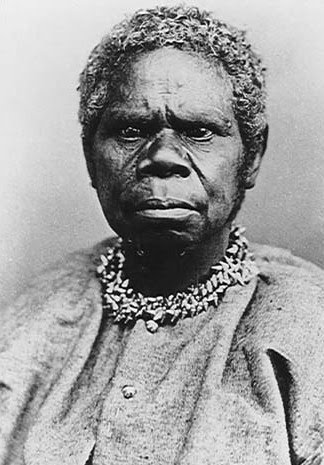
The Australian rock band Midnight Oil advocated strongly for the rights of indigenous Australians. Their most successful singles, "Beds are Burning" and "Thje Dead Heart" brought the plight to those indegenes to the attention of an international audience. Their tribute to Truganini highlights the multi-generational effects of colonialism, the contemporary disregard for both indigenes and the work they do, and the dominance of the new colonizers, multi-national corporations.
Truganini
Midnight Oil
from Earth and Sun and Moon (1993)
There's a road train going nowhere
Roads are cut, lines are down
We'll be staying at the Roma Bar
Till that monsoon passes on
The backbone of this country's broken
The land is cracked and the land is sore
Farmers are hanging on by their fingertips
We cursed and stumbled across that shore
I hear much support for the monarchy
I hear the Union Jack's to remain
I see Namatjira in custody *
I see Truganini's in chains
And the world it won't stand still
Blue collar work it don't get you nowhere
You just go round and round in debt
Somebody's got you on that treadmill, mate
And I hope you're not beaten yet
I hear much support for the monarchy
I see the Union Jack in flames, let it burn
I see Namatjira with dignity
I see Truganini's in chains.
* Albert Namatjira was an Arrernte painter from the MacDonnell Ranges in Central Australia, a pioneer of contemporary Indigenous Australian art. He was the first Aboriginal artist to receive popularity from a wide Australian audience.
In 1967 the Australian government first recognized Australian Aboriginal people as citizens in their own land. Before then, Aboriginal people and Torres Strait Islanders were considered "wards of the state," and thus not actual citizens. But Namatjira's popularity was such that he was the first recorded Northern Territory Aboriginal person to be freed from those restrictions; he was granted the rights of citizenship in 1957. This gave him the right to vote in national, state, and territory elections, gave him freedom of movement, and freed him from restrictions on buying alcohol.
However, the lyrics here refer to the fact that Namatjira was still poorly treated by the state and national governments. Just one year after being granted citizenship, the Alice Springs Police charged him with supplying alcohol to Aboriginal people because he left a bottle of rum on the back seat of his car. The rum was stolen, and the man who took it then got drunk and killed his wife. Namatjira denied the charge and fought the sentence he received in both the Supreme Court and the High Court. He was originally sentenced to six months imprisonment with labor. Following a public outcry and two appeals, the sentence was reduced to three months. He eventually served two months of open detention at the Papunya settlement in March-May 1959. By August of that year he was dead.
Trugernanner (Truganini) (1812-1876)
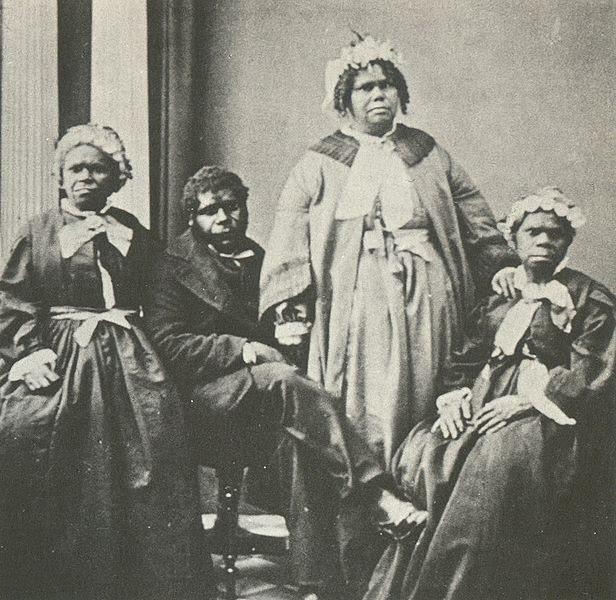
(Truganini) Trugernanner (1812?-1876), Tasmanian Aboriginal, was born in Van Diemen's Land on the western side of the D'Entrecasteaux Channel, in the territory of the south-east tribe. Her father was Mangerner, leader of one of the tribe's bands, and in her adolescence she was associated with its traditional culture, making occasional visits to Port Davey. The tribe was disrupted by European sealers, whalers and timber-getters; by March 1829, when she and her father met G. A. Robinson at Bruny Island, her mother had been killed by sailors, her uncle shot by a soldier, her sister abducted by sealers, and Paraweena, a young man who was to have been her husband, murdered by timber-getters. At Bruny Island mission in 1829 she 'married' Woorraddy, from Bruny. They were associated with all the missions that Robinson and his sons conducted around Tasmania in 1830-35; they acted as guides and as instructors in their languages and customs, which were recorded by Robinson in his journal, the best ethnographic record now available of traditional Tasmanian Aboriginal society.
Trugernanner, Woorraddy and other Aborigines from Robinson's mission arrived at the Flinders Island settlement in November 1835. With the hundred or so captured Aborigines still alive they were to be 'christianized and europeanized' and taught to be farmers. She was renamed Lallah Rookh by Robinson, but held to her traditional ways. In March 1836 she and Woorraddy returned to Tasmania to search in vain for the one family remaining in the north-west. By July 1837 when they went back to Flinders Island, many had died there and Robinson's programme had proved unsuccessful. Trugernanner told him that all the Aborigines would be dead before the houses being constructed for them were completed.
In February 1839, with Woorraddy and fourteen other Aborigines, she accompanied Robinson to Port Phillip. She and four others, without Woorraddy, later joined a party of whalers near Portland Bay. In 1841 all five Aborigines were charged with the murder of two whalers and in January 1842 the two men were hanged. In July Trugernanner and two other women, Fanny and Matilda, were sent back to Flinders Island with Woorraddy who, however, died en route. She lived with the Aborigine Alphonso until October 1847 when, with forty-six others, she moved to a new establishment at Oyster Cove, in her traditional territory. She resumed much of her earlier life-style, diving for shellfish, visiting Bruny Island by catamaran, and hunting in the near-by bush. By 1869 she and William Lanney were the only full bloods alive. The mutilation of Lanney's body after his death in March led Trugernanner to express concern; she told Rev. H. D. Atkinson, "I know that when I die the Museum wants my body."
In 1874 she moved to Hobart Town with her guardians, the Dandridge family, and died in Mrs Dandridge's house in Macquarie Street on 8 May 1876, aged 64. She was buried at the old female penitentiary at the Cascades at Midnight on 10 May. Her body was exhumed in December 1878 by the Royal Society of Tasmania, authorized by the government to take possession of her skeleton on condition that it be not exposed to public view but "decently deposited in a secure resting place accessible by special permission to scientific men for scientific purposes." But it was placed in the Tasmanian Museum where it was on public display in 1904-47. Trugernanner was the most famous of the Aboriginal Tasmanians, but her life is shrouded in myth and legend. As the faithful companion of Robinson in 1829-35, she assisted in bringing in her compatriots because she wanted to save them from European guns. The establishment at Flinders Island was a grave disappointment to her. Small in stature, forceful, gifted and courageous, she held European society in contempt and made her own adjustment on her own terms.
George Augustus Robinson (1791-1866)
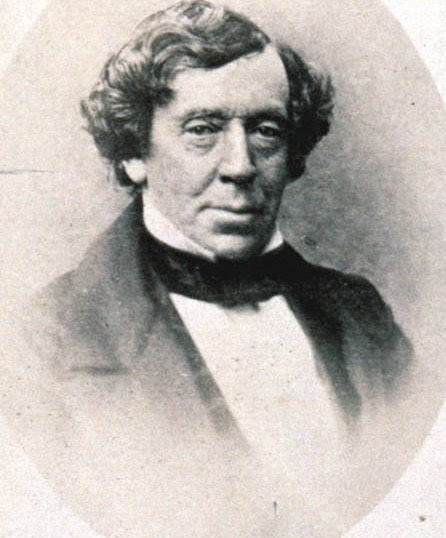
George Augustus Robinson (1791-1866), protector of Aboriginals, was born on 22 March 1791 probably in London, a younger son of William Robinson, a builder in Boston, Lincolnshire, and his wife Susannah, née Perry, of Yeovil, Somerset. His youth was probably spent in London with his family at Islington. He had little formal schooling but educated himself by reading widely. He was employed for some years in the Engineers' Department at Chatham, and was connected with, and possibly superintended, the building of some of the martello towers on the east coast of England. On 28 February 1814 in London he married Maria Amelia Evans. Some jottings among his papers show that he was then in the building trade and interested in religious activities.
Early in 1822 Robinson was considering emigration. His first choice was America, and he seems to have booked his passage to the Poyais settlement in Nicaragua. News reached England about June 1823 of the fraudulent nature of that enterprise, and Robinson decided to emigrate to the Australian colonies instead. Leaving his wife and five children behind he sailed from Leith in theTriton, travelling steerage. His journal on the voyage shows him as serious and religious, thoughtful in conversation yet companionable and sharing in quiet conviviality. He arrived in Hobart Town in January 1824 and soon set up as a builder. Within a year he was employing several men and had accumulated some £400, but in spite of this rosy picture be could not persuade his wife to join him with their children until April 1826. In Hobart Robinson became secretary of the Seamen's Friend and Bethel Union Society, joined the committee of the Auxiliary Bible Society, visited prisoners and the condemned in the gaol, and helped to found the Mechanics' Institute.
At the time of Robinson's arrival, relations between Aboriginals and settlers had almost reached the stage of open hostility, a result partly of the usurpation of the natives' hunting grounds, partly of the cruel treatment and killing of natives by shepherds, stockmen, bushrangers and sealers, partly of the kidnapping of native children. Relations continued to deteriorate and Lieutenant-Governor(Sir) George Arthur increased punitive measures in an attempt to solve a problem which, from the viewpoint of the settlers, seemed to require either the extermination of the Aboriginals or their removal from lands that the settlers wanted to possess. Many colonists spoke of conciliation but little was done, although Arthur never wholly gave up the idea. The successful rationing of Aboriginals on Bruny Island, begun in May 1828, induced the government to advertise next March for a steady man of good character to effect an intercourse with the natives. Robinson believed that conciliation was possible, applied for the position and was appointed.
On 30 March 1829 Robinson left Hobart for Bruny Island. He spent a few weeks in getting to know the Aboriginals and in looking for a suitable spot for a settlement where he hoped to civilize them and teach them Christian principles. His native village was to have huts, a school and a potato ground; the Aboriginals were to be prevailed upon to settle down, adopt European habits and till the soil, with their children learning trades. English was to be the language of the settlement and Bell's system was to be used in the school. However, the scheme had scarcely begun when Robinson realized that he must become well acquainted with the customs and language of the Aboriginals. By June he was proposing that he should visit the tribes of the south coast to acquaint them with Arthur's humane intentions. On 27 January 1830 he left Hobart for Port Davey, where he explored and met a party of Aboriginals. He then went up the west coast, for a time in their company, and reached Macquarie Harbour on 20 April. After a few days rest he continued north arriving at the Van Diemen's Land Co.'s settlement at Cape Grim on 14 June. Moving east he reached Launceston on 2 October. For the rest of 1830 and most of 1831 Robinson was in north-eastern and eastern Tasmania and on the islands in Bass Strait seeking information about the sealers. From October to December 1831 he was in central Tasmania searching for the feared Big River and Oyster Bay Aboriginals, but when he finally came up with them only sixteen remained. His return to Hobart with the captives was deemed a Roman triumph. From February to November 1832 Robinson was in north-western Tasmania, from December 1832 to October 1833 round Macquarie Harbour, and from December 1833 to August 1834 in the north-west again. He had circled the island and visited all the existing tribes, but although he had seen as much of the country as any of his contemporaries, his observations did not influence exploration or open new areas for settlement. He recorded his journeys minutely in his journals, but there the information remained: he was interested only in the natives.
The pattern of each expedition was much the same. Robinson had his two elder sons, an escort of convict porters and servants, and a following of at least a dozen friendly natives; a boat was used along the coast. When first approaching a tribe the Europeans kept in the background while the friendly Aboriginals went forward, made contact and persuaded the tribe to come to Robinson, who would give them presents and food. At first Robinson concentrated on establishing friendly relations with the tribes, but in the second expedition he began persuading them to come into captivity, promising them a place where they could live unmolested by the settlers and be fed and clothed. Those giving themselves up were sent to Bass Strait where, after several changes, a permanent settlement was established on Flinders Island.
Robinson had begun his work from motives of compassion: hoping to help the Aboriginals and improve their conditions, he readily sacrificed financial security and the comforts of his home. As his plans succeeded, however, he became less patient with the natives and more interested in financial rewards. With natural vanity he came to think that he alone had worthwhile ideas on the treatment of Aboriginals, alone had their welfare at heart, alone had been responsible for their capture. These views were largely true, but they did not win him friends.
By August 1834 the Aboriginal problem, as the colonists saw it, had been settled, since all but about a dozen natives had been removed from the mainland to the Flinders settlement. This had its beginnings on Swan Island in November 1830. Although under Robinson's general superintendence, it was largely managed by commandants who had little interest in their charges and behaved like gaolers. Mortality had been severe, and by 1835 the Aboriginal population, estimated at about 4000 before European settlement began, had shrunk to fewer than 150 natives, of whom about half were the survivors of those sent by Robinson to Flinders Island. Introduced disease was now rapidly reducing the number of survivors.
When Robinson himself took control at the Flinders settlement in October 1835 he first set out to provide adequate food supplies and to improve housing; but his greatest change was to root out Aboriginal culture and to attempt its replacement with a nineteenth century peasant culture. Schools were established in which the natives were taught to read and write. Catechetical religion took a prominent place in all the instruction. The teachers were drawn from the Europeans in the settlement and from those native children who had learned to read and write at the Hobart Orphan School. Attempts were made to "civilize" the natives in other ways: markets were held where they were taught to buy and sell in hope that they would come to realize the value of property; they were given new names and taught to elect their own native police. The experiment failed, partly because the natives were dying off rapidly, but chiefly because no culture can be uprooted without being replaced by an adequate and acceptable substitute.
Robinson's work among the Tasmanian Aboriginals had more than a local interest, because Arthur, once he had seen that conciliation could prevent the inevitable clash between the colonizing power and the native inhabitants, was anxious that it should be tried in the newer Australian colonies to prevent a recurrence of what he had experienced in Tasmania. As early as 1832 Arthur suggested that Robinson might practise the principles of conciliation at Spencer Gulf or Swan River, and in February 1835 he was asked to undertake such work at Portland Bay. This scheme came to nothing, but in August 1836 Robinson was offered appointment as protector of Aboriginals in South Australia; he refused it because the salary was less than he thought he deserved. Some two years later he was offered the chief protectorship at Port Phillip, and as he considered the salary adequate he accepted.
Robinson left Flinders Island for Port Phillip in February 1839. His departure marked the end of a vision, the saving of the Tasmanian race. He spent nearly eleven years at Port Phillip, but his work there was not impressive. Unlike the Tasmanian tribes the Victorian Aboriginals, on whom he tried to thrust his idea of civilization, were free to come and go as they pleased. His handling of the affairs of the protectorate was weak, anything of value coming from his sub-protectors, although he made several noteworthy overland journeys to South Australia, New South Wales and the Murray valley, the day-to-day record of these in his journals giving valuable information about the tribes and the state of the country he traversed.
The Port Phillip protectorate was abolished on 31 December 1849 leaving Robinson free to do as he wished. He was well off and had a pension. His wife had died in September 1848; except for his daughter Cecelia his family was grown up. He could afford to live in comfort. In May 1852 he sailed in the Medway for London. There on 4 June 1853 he married Rose, daughter of Thomas Pyne, an accountant; five children of this marriage survived. The Robinsons lived on the Continent, mostly in Rome and Paris, until about June 1858, when they returned to England and next year settled in Bath. The sojourn in Europe and particularly at Bath, brought to Robinson much of what he wanted: comfortable living and social acceptance, as well as a place among the followers of the arts and sciences. He died in Bath on 18 October 1866.
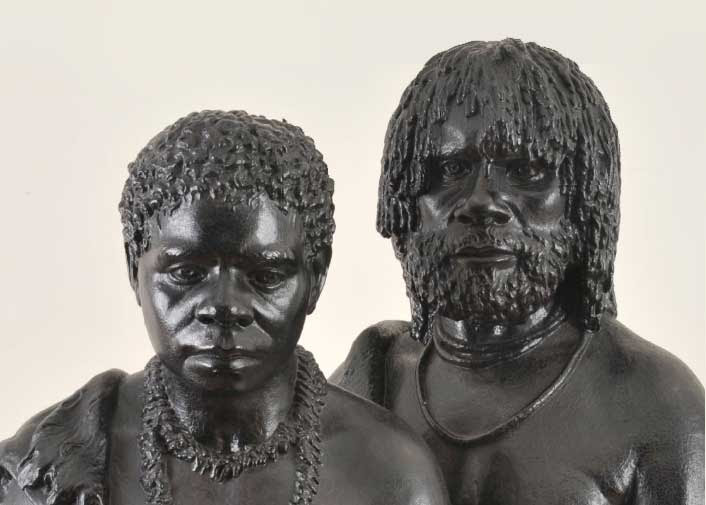
Truganini and Woureddy — sculpture by Benjamin Law
Truganini icon — Panagiota Koyvari and Gigas
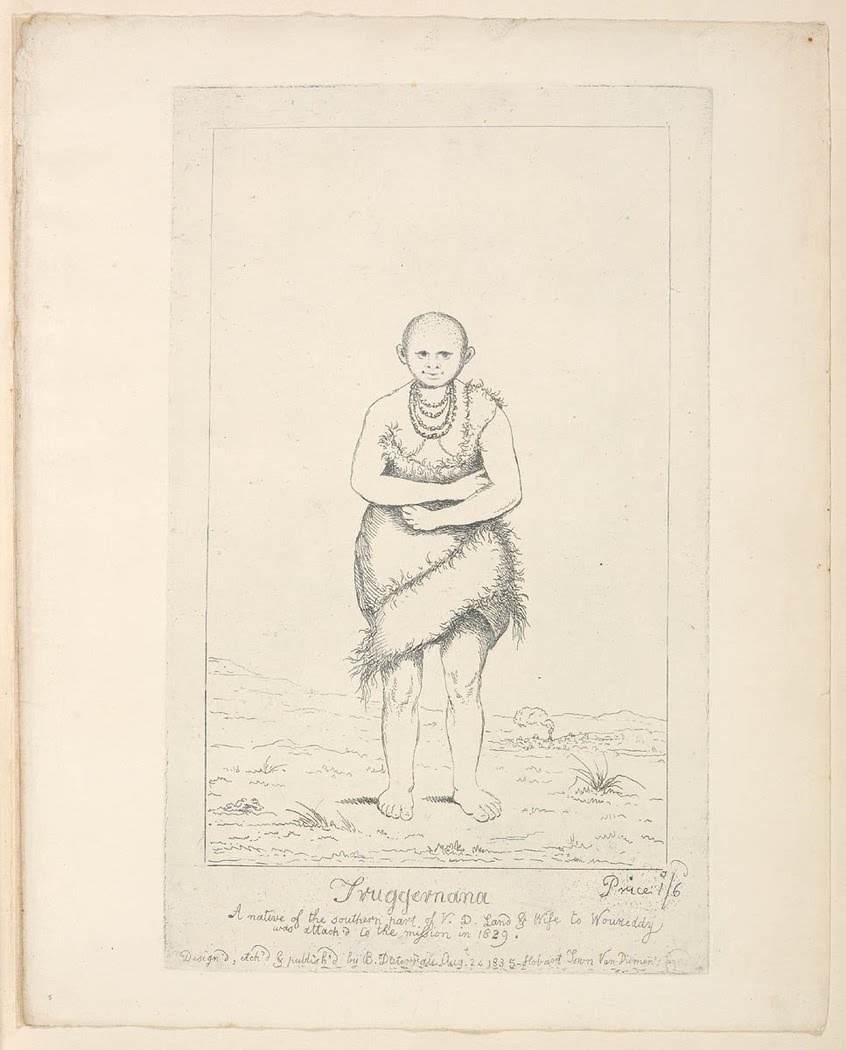
Truggernana: A native of the southern part of V.D. Land & Wife
to Woureddy who was attached to the mission in 1829.
from The Aborigines of Tasmania — A Series of Original Etchings and Sketches of the Natives
brought in by the Conciliatory Mission under G. A. Robinson. — Hobart Town, 1834-35, by Benjamin Duterrau.